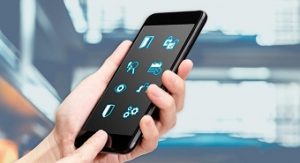
In business and at home, the smartphone is a remote control for our lives. It’s a calendar and a credit card. We book holidays and do our daily banking. With video calling technology, we can even be in two places at once (or make it seem that way). Could there be untapped potential in using mobile phones for access control, too?
According to official EU data, by 2016, 94% of European large businesses were issuing their workers with some sort of connected mobile device. We seem to use our smartphones for everything. Yet mobile phones are actually under-utilized when it comes to building security and access management.
Evolving technologies now enable us to manage access rights via mobile phone apps, open a door with a virtual key credential, and much more. An estimated 44 million mobile credentials will be downloaded by 2021, according to a recent IHS Markit forecast.
Why? Because a mobile phone is so well adapted to controlling access at the workplace:
• It is convenient: part of the reason Apple Pay, Instagram and many more mobile services succeed is for the simple reason, we like to carry less stuff. With secure credentials on your phone, there’s no more need for a fob, a plastic smart-card or anything similar.
• It is secure: a screen-lock adds an extra layer of PIN, swipe passcode or fingerprint security. With phones, multi-factor authentication is baked into the credential. And how quickly would you notice if a plastic key-card went missing? Nowhere near as fast as you’d spot your smart phone was gone.
• It is flexible: security and facility managers can do things with virtual keys that are impossible with a plastic credential. They can issue, revoke or amend them instantly and from anywhere with secure cloud access via a mobile phone. However briefly a temporary visitor needs to enter your building, the easiest way to let them in is with their phone.
• It is efficient: scrap the queues at reception waiting for temporary visitor permits, waste fewer hours in plastic key-card handover meetings and spend less of your budget replacing lost and damaged credentials. Phone-based access control saves businesses time and money.
• It is compatible: mobile phones are machines built for connectivity, including with your existing RFID locks. Bluetooth and NFC radio technology are already inside most modern smartphones. Every future viable wireless and contactless technology will be there, too.
Another recent analyst report suggested as many as 20% of organisations would use smartphones for access, in place of plastic smart-cards, by 2020. The move to mobile access control seems inevitable.
“Other highly security-aware industries like banking demonstrate the advantages of the smartphone,” says Thomas Schulz, Director Marketing & Communications Digital and Access Solutions at ASSA ABLOY, EMEA. “Similarly, we see fast-growing interest in unlocking doors and other openings with mobile credentials, and in facility managers administering access rights via their smartphone.”
“To take one example from our portfolio of mobile access solutions, security managers using our new SMARTair® Openow™ solution manage all users’ virtual keys inside a secure app. If an administrator cancels a virtual key, it vanishes immediately from a user’s Openow™ app.”
Schulz points to the new Arkansas State University campus in Mexico, where students and staff have no access cards to collect or validate. Every site user installs and validates their own Openow™ app and collects keys virtually.
“Smartphones add convenience and functionality right across our wireless access control product and solutions portfolio,” adds Schulz. “Users can unlock our Aperio® wireless locks with a Seos® mobile credential. Small and medium-sized business managers can run their own access control with no specialist knowledge, using just the CLIQ® Go app and their phone. For companies with a remote workforce, the CLIQ® Connect app updates access rights of programmable keys with just a secure Bluetooth connection. “Access control from your mobile phone offers so many efficiency advantages. I’d encourage everyone involved in managing access control to take a look.”











